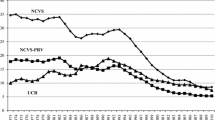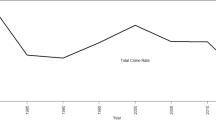Abstract
Objectives
This study uses UCR and NCVS crime data to assess which data source appears to be more valid for analyses of long-term trends in crime. The relationships between UCR and NCVS trends in violence and six factors from prior research are estimated to illustrate the impact of data choice on findings about potential sources of changes in crime over time.
Methods
Crime-specific data from the UCR and NCVS for the period 1973–2012 are compared to each other using a variety of correlational techniques to assess correspondence in the trends, and to UCR homicide data which have been shown to be externally valid in comparison with other mortality records. Log-level trend correlations are used to describe the associations between trends in violence, homicide and the potential explanatory factors.
Results
Although long-term trends in robbery, burglary and motor vehicle theft in the UCR and NCVS are similar, this is not the case for rape, aggravated assault, or a summary measure of serious violence. NCVS trends in serious violence are more highly correlated with homicide data than are UCR trends suggesting that the NCVS is a more valid indicator of long-term trends in violence for crimes other than robbery. This is largely due to differences during the early part of the time series for aggravated assault and rape when the UCR data exhibited consistent increases in the rates in contrast to general declines in the NCVS. Choice of data does affect conclusions about the relationships between hypothesized explanatory factors and serious violence. Most notably, the reported association between trends in levels of gasoline lead exposure and serious violence is likely to be an artifact associated with the reliance on UCR data, as it is not found when NCVS or homicide trend data are used.
Conclusions
The weight of the evidence suggests that NCVS data represent more valid indicators of the trends in rape, aggravated assault and serious violence from 1973 to the mid-1980s. Studies of national trends in serious violence that include the 1973 to mid-1980s period should rely on NCVS and homicide data for analyses of the covariates of violent crime trends.



Similar content being viewed by others
Notes
Data for these analyses are available in ICPSR data sets 7635, 8608, 8864, 4699, and 34907. For more information, see http://icpsr.umich.edu/NACJD/NCVS.
Research by Nevin and others (e.g., Reyes 2007a, b) use different lags in lead exposure to best fit the UCR crime trend data. For example, Nevin (2000) uses a best-fit lag structure in which lags of 15–28 years in gasoline lead exposure were tested against each crime type and the lag with the highest R2 and lowest p value was selected. Nevin (2000) uses a lag of 23 years for violent crime, which we have replicated here, though we also produce the same substantive findings when using a 22-year lag (following Reyes 2007a).
Prior to 1978, U.S. consumption of tetraethyl lead in gasoline was reported in short tons. The U.S. Geological Society began reporting these data in metric tons after 1978. Therefore, we multiplied metric tons by 1.10231 to convert the data into short tons (see U.S. Energy Information Administration 2015).
Persons over age 25 are typically beyond the age of college completion. The NCVS does not measure current college enrollment across all years for persons over age 25, therefore we rely on work and military service as indicators of young adult engagement in conventional social institutions.
To minimize the effect of sampling error and make it easier to compare long-term trends, three-year moving averages are used for the NCVS trends. Figures and analyses based on unsmoothed NCVS rates exhibit no substantive differences from those based on the smoothed rates and are available upon request from the authors.
The only trend to not exhibit an increase around 2006 was the UCR series for rape.
Not surprisingly, these correlations are only somewhat different from those reported for 1973–2008 in Ansari and He (2012). For robbery and aggravated assault, their correlations are .83 and .02, respectively, and for burglary and motor vehicle theft they are .95 and .84.
To better see the crime-specific trend correspondence in these figures, the UCR rape rates are multiplied by 10 and the NCVS rape rates are multiplied by 2 prior to log transformation.
We also note that recent crime trends research suggests that the relationships between factors such as consumer pessimism and violence appear to change beginning in the early 2000s (e.g., Lauritsen and Heimer 2010). Existing research has not yet accounted for such changes, but these changing relationships suggest that other factors associated with the more recent period may be moderating these relationships (e.g., perhaps through improvements in policing, other macro-social changes, or a combination of such factors).
For purposes of display, the logged lead estimate used in this figure is multiplied by 5.25 to better illustrate its similarities to the UCR serious violent crime measure.
It is also the case that both aggravated assault and rape are crimes that are much more likely to be committed by non-strangers and to involve women as victims—incidents that in the past were more often considered to be private affairs and not conform to stereotypical views of crime.
Reyes (2007a:2) claims that “…between 1992 and 2002, the phase-out of lead from gasoline was responsible for approximately a 56 % decline in violent crime.”.
References
Ansari S, He N (2012) Convergence revisited. A multi-definition, multi-method analysis of the UCR and NCVS crime series: 1973–2008. Justice Q 29:1–31
Barnett-Ryan C, Langton L, Planty M (2014) The nation’s two crime measures. U.S. Department of Justice, Washington, DC
Baumer E (2008) An empirical assessment of the contemporary crime trends puzzle: a modest step toward a more comprehensive research agenda. In: Goldberger A, Rosenfeld R (eds) Understanding crime trends: workshop report. National Academies Press, Washington, DC
Baumer E, Lauritsen J (2010) Reporting crime to the police, 1973–2005: a multivariate analysis of long term trends in the National Crime Survey (NCS) and National Crime Victimization Survey (NCVS). Criminology 48:131–185
Berg M, Lauritsen J (2015) Telling a similar story twice? NCVS/UCR convergence in serious violent crime in rural, suburban and urban places (1973–2010). J Quant Criminol. doi:10.1007/s10940-015-9254-9
Biderman A, Lynch J (1991) Understanding crime incidence statistics: why the UCR diverges from the NCS. Springer, New York
Blumstein A, Cohen J, Rosenfeld R (1991) Trend and deviation in crime rates: a comparison of UCR and NCS data for burglary and robbery. Criminology 29:237–263
Bureau of Justice Statistics (1986) State and federal prisoners, 1925–85. U.S. Department of Justice, Washington, DC
Bureau of Justice Statistics (no date) Correctional statistics analysis tool (CSAT)—prisoners. Retrieved from: http://www.bjs.gov/index.cfm?ty=nps
Bureau of Labor Statistics (no date-a) Labor force statistics from the Current Population Survey. Retrieved from: http://data.bls.gov/pdq/querytool.jsp?survey=ln
Bureau of Labor Statistics (no date-b) Consumer price index. Retrieved from: http://www.bls.gov/cpi/
Cantor D, Land K (1985) Unemployment and crime rates in post-World War II United States: a theoretical and empirical analysis. Am Sociol Rev 50:317–332
Drum K (2013) America’s Real Criminal Element. Mother Jones, San Francisco, CA
Jensen G, Karpos M (1993) Managing rape: exploratory research on the behavior of rape statistics. Criminology 31:363–385
Kindermann C, Lynch J, Cantor D (1997) Effects of the redesign on victimization estimates. U.S. Department of Justice, Washington, DC
Lauritsen J, Heimer K (2010) Violent victimization among males and economic conditions: the vulnerability of race and ethnic minorities. Criminol Public Policy 9:665–692
Loftin C, McDowall D (2010) The use of official records to measure crime and delinquency. J Quant Criminol 26:527–532
Lynch J, Addington L (eds) (2007) Understanding crime statistics: revisiting the divergence of the NCVS and UCR. Cambridge Press, Cambridge
Lynch J, Jarvis J (2008) Missing data and imputation in the uniform crime reports and the effects on national estimates. J Contemp Crim Justice 24:69–85
Maltz M, Targonski J (2002) A note on the use of county-level UCR data. J Quant Criminol 18:297–317
McCall P, Land K (2004) Trends in environmental lead exposure and troubled youth, 1960–1995: an age-period-cohort characteristic analysis. Soc Sci Res 33:339–359
McDowall D, Loftin C (2007) What is convergence and what do we know about it? In: Lynch J, Addington L (eds) Understanding crime statistics: revisiting the divergence of the NCVS and UCR. Cambridge Press, Cambridge
Nevin R (2000) How lead exposure relates to temporal changes in IQ, violent crime, and unwed pregnancy. Environ Res 83:1–22
O’Brien R (1996) Police productivity and crime rates: 1983–1992. Criminology 34:187–207
Reyes J (2007a) Environmental policy as social policy? The impact of childhood lead exposure on crime. Working Paper 13097, National Bureau of Economic Research
Reyes J (2007b) Environmental policy as social policy? The impact of childhood lead exposure on crime. BE J Econ Anal Policy 7:1–41
Rosenfeld R (2007) Explaining the divergence between UCR and NCVS aggravated assault trends. In: Lynch J, Addington L (eds) Understanding crime statistics: revisiting the divergence of the NCVS and UCR. Cambridge Press, Cambridge
Rosenfeld R (2015) Crime and inflation in cross-national perspective. In: Tonry M (ed) Why crime rates fall and why they don’t: crime and justice: a review of research, vol 43. University of Chicago Press, Chicago
Rosenfeld R, Fornango R (2007) The impact of economic conditions on robbery and property crime: the role of consumer sentiment. Criminology 45:735–769
Smith E, Cooper A (2013) Homicide in the U.S. known to law enforcement, 2011. U.S. Department of Justice, Washington DC
Thomas S, Shihadeh E (2013) Institutional isolation and crime: the mediating effect of disengaged youth on levels of crime. Soc Sci Res 42:1167–1179
U.S. Census Bureau (no date) Historical national population estimates: July 1, 1900 to July 1, 1999. Population Estimates Program, Population Division
U.S. Energy Information Administration (2015) How do I convert between short tons and metric tons? Frequently asked questions. Retrieved from: http://www.eia.gov/tools/faqs/faq.cfm?id=7&t=2
U.S. Environmental Protection Agency (1985) National air quality and emissions trends report, 1983. Washington, DC
Woodbury W (1991) Bureau of Mines Minerals Yearbook: lead. U.S. Geological Society, Reston, VA
Acknowledgments
We are grateful to the members of the National Academy of Sciences’ Roundtable on Crime Trends and to anonymous reviewers for their helpful comments on earlier versions of this manuscript.
Author information
Authors and Affiliations
Corresponding author
Rights and permissions
About this article
Cite this article
Lauritsen, J.L., Rezey, M.L. & Heimer, K. When Choice of Data Matters: Analyses of U.S. Crime Trends, 1973–2012. J Quant Criminol 32, 335–355 (2016). https://doi.org/10.1007/s10940-015-9277-2
Published:
Issue Date:
DOI: https://doi.org/10.1007/s10940-015-9277-2




